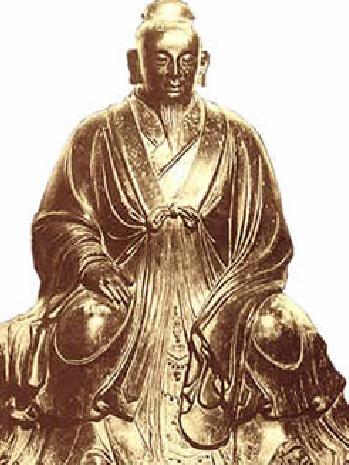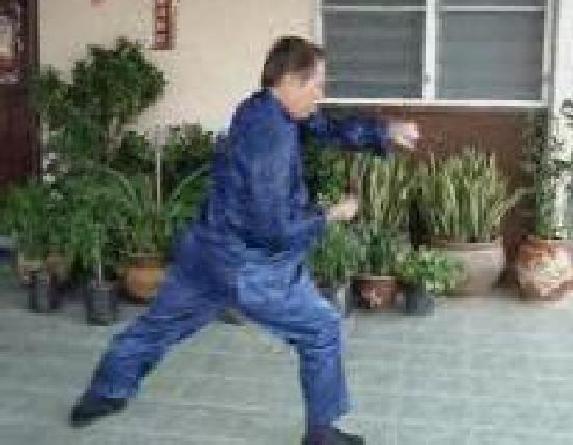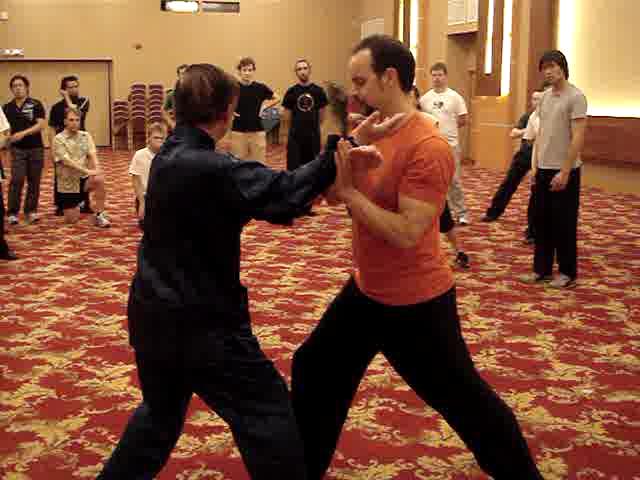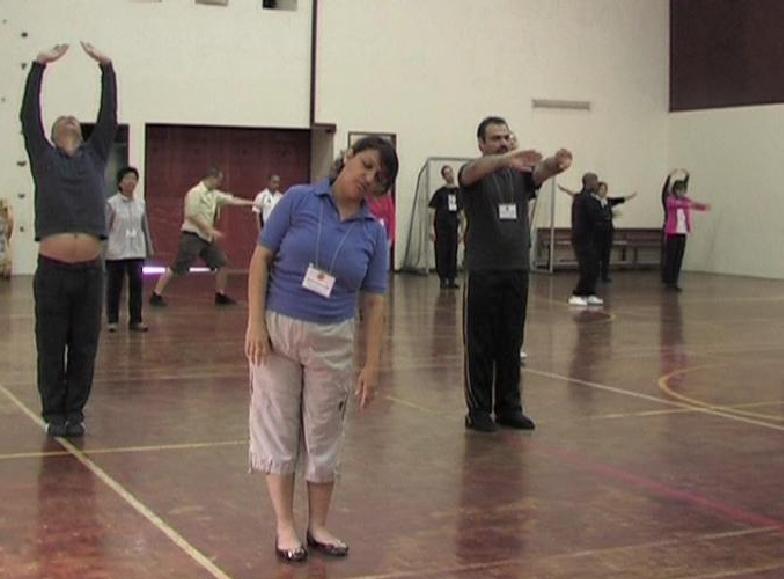SELECTION OF QUESTIONS AND ANSWERS
MARCH 2011 PART 2

The Taoist Immortal Zhang San Feng
Question 1
I have always been fascinated by the different ways different styles handle similar combat situations. Thank you for giving courses of different styles like Wing Choon and Eagle Claw which I enjoyed taking part and benefited from.
— Sifu Robin Gamble, Thailand
Answer
Now let us see how Eagle Claw Kungfu overcomes the same situation of an opponent with much internal force and strong arms tying you up preventing you to use your combat sequences. It is interesting and rewarding to see the comparison.
Eagle Claw is very rich in this respect. You can take any one of the 50 sequences you learned at the Eagle Claw Course at the UK Summer Camp 2009. Isn't it fascinating! You can take any one of the 50 sequences!
How could this be? How could any one of the 50 sequences be used against a big, strong opponent with much internal force? Are some sequences good for some particular situations, like kicks and strikes, some for other situations, like throws and wrestling, and a few for big, strong opponents with powerful arms?
No, this premise is not true for us. It is only true for those with low skill levels or those who practice low-level arts, in which case they have to cross-train. As I write this, I am aware that many other people would criticize us as being arrogant. If, instead of taking this as good advice that may enable them to improve themselves or their arts, they take it as an insult, which is never meant to be, that is their problem, not ours.
But for those who have deep understanding of kungfu philosophy and practical skills, they can apply any one of 50 sequences of a high-level kungfu like Eagle Claw for any combat situations -- including in odd situations like when your both arms are being held from behind, or you have been pinned down on the ground!
Let us take the first Eagle Claw sequence, Press Strike, to see how it deals with a big, strong opponent with powerful arms tying you down. As he attempts to tie your arms, sink down your stance, move one arm, say your left arm, round his two arms and press them down, while simultaneously strike him with your other fist, i.e. your right fist, at your left Bow-Arrow Stance.
Your sinking down your stance following his pressing momentum would release his tying or pressing on you. If his stance is not good, despite his size and strength he may lose balance and fall forward where your right fist would crush into his face.
If he moves back or attempts to ward off your punch, grip his left elbow from below with your right eagle claw, jerk it to your left side so that his left arm held by you blocks his right hand, simultaneously turn your body, change into a right Bow-Arrow Stance and smash your left fist into his face.
Your turning of your body effected by the rotation of your waist, like an eagle turning in the air, neutralizes the opponent's advantage of his size and strength. Your gripping at the soft spots of his elbow and jerking it aside, off balances him and puts him in an awkward position where you can strike him effectively.
Again you need to support your techniques with tactics and strategies. If you just attempt to grip his elbow from scratch, you are unlikely to succeed, especially when he has powerful arms. You tempt him to press or tie you down, which is his strong point. Then you turn his strong point into his weakness.
Question 2
These different styles greatly enrich our understanding of the style we have chosen.
Answer
I believe we in Shaolin Wahnam have arrived at a very special point in kungfu history. We are now in a very special and privileged position to offer our students and instructors a wide variety of kungfu styles as well as relevant arts, like business negotiation, singing and art appreciation, which not only enhance our kungfu performance but more significantly also enrich our daily lives.
In this discussion, let us just focus on kungfu performance. Besides Shaolin Kungfu and Wahnam Taijiquan, we also have Tantui, Eagle Claw, Iron Wire, Wing Choon, Hoong Ka Triple Stretch, and Praying Mantis. Flower Set, Drunken Eight Immortals, and San Zhan from Wusu Kungfu are on their way.
If just one out of the 50 Eagle Claw sequences can be used to overcome any combat situations, isn't it a waste of time to learn so many kungfu styles and kungfu sets? Of course, the answer is "No."
What is said about Eagle Claw is also true for the other styles. We can just use the first sequence of Tantui (in fact we did that during the UK Summer Camp 2007), or any one sequence from Triple Stretch or Flower Set to overcome any combat situations! We can also use just one pattern from Wing Choon, Flower Set or Drunken Eight Immortals to neutralize any attacks!
It is precisely because we have learnt many different sets and styles that we are able to come to this rare and privileged position. If we concentrate on just one style, we shall be limited to the philosophy and practice of only this one style.
Our rare and privilege position now enables us to aspire to attainment only a few rare grandmasters in the past could aspire to. You can aspire to attain a level not just of Yang Lu Chan but of Zhang San Feng. Others like Tim, Anthony Spinicchia, Roland and Markus can aspire to levels not just of Yim Wing Choon, Thiet Kiew Sam, Wang Lang and Fong Sai Yoke, but of Ng Mui, Pak Mei and Chee Seen.
Yang Lu Chan was without doubt a great fighter. But there was a distinct difference in class between him and Zhang San Feng. Similarly, without doubt Yim Wing Choon, Thiet Kiew Sam, Wang Lang and Fong Sai Yoke were great fighters, but there was a distinct difference in class between them on one hand and Ng Mui, Pak Mei and Chee Seen on the other hand.
Yang Lu Chan reached top excellence in Taijiquan, while Yim Wing Choon, Thiet Kiew Sam, Wang Lang and Fong Sai Yoke reached top excellence in Wing Choon Kungfu, Iron Wire, Praying Mantis and Flower Set. On the other hand Zhang San Feng, Ng Mui, Pak Mei and Chee Seen were all-rounders.
Although we now often refer to Zhang San Feng as the First Patriarch of Taijiquan, during his time he was never known as a Taijiquan grandmaster. (The term "Taijiquan" was not coined yet.) But the best of Yang Lu Chan's Taijiquan was still far off from the general internal arts of Zhang San Feng.
Ng Mui was never specially known for her "chi sau", nor Pak Mei specially known for his Iron Arm. But I believe that the best of Yim Wing Choon's "chi sau", and the best of Thiet Kiew Sam's Iron Arm would still be far off from the general arts of Ng Mui and Pak Mei, even if we just compare their arm sensitivity and arm forcefulness.
When we say that we have the opportunity to aspire even beyond what past masters like Yang Lu Chan, Yim Wing Choon and Thiet Kiew Sam aspired to, of course we never mean that we are as good as them. I believe our attainment is still low when compared with that of these past masters. But we have resources that these past masters did not have. Yang Lu Chan, for example, had no resources to learn Iron Wire, nor Thiet Kiew Sam to learn Grasping Sparrow's Tail - regardless of whether they needed it. Yet, we now have resources that were unthinkable even as recent as 50 years ago!
Editorial Note: Sifu Robin Gamble's other questions can be found here.

How would this "Press-Strike" of Eagle Claw be employed to overcome an opponent with powerful arms?
Question 3
I have recently resumed qigong after stopping for a few years after learning from you in Bath, England around 2002.
— Fawat, USA
Answer
It is good that you resume your qigong practice. You may find that it is one of the best things you have done for your health and vitality.
As you have not practiced for many years, you may have lost the skills you gained when you learned from me in Bath.
In chi kung training, skills are more important than techniques. This is an important fact that many practitioners do not realize, and many of them have wasted a lot of time, in matters of years, for this mistake. A very common but insidious example is that literally thousands of people today all over the world practice chi kung with little or no chi kung benefits. Their techniques are correct, but they lack the skills to perform the techniques as chi kung, they merely perform the techniques as physical exercise. Therefore, they only derive physical benefits like loosening their muscles and joints.
Your case, however, seems worse. You practice the techniques as chi kung, but you do so wrongly. Hence, not only you do not get physical benefits but you get adverse effects instead. But you need not worry. Your mistakes are not serious, at least not yet, and can be readily rectified. It is best if you attend another chi kung course conducted by me or any of our certified instructors, but if this is not feasible, you can just follow the advice below.
Question 4
A few times I have come up against this problem and now face it again: I figure I am accidentally breathing incorrectly or perhaps it is a mental aspect, thinking too hard. I keep my body extremely relaxed and keep checking it. After a while of practising "Lifting the Sky" I start to feel "congestion" in my head, the longer I go for the worse it will get.
I am also very conscious that when I breathe relaxed for pushing up the sky and breath relaxed "inviting the breath in", I seem to only breath in very gently a very short amount of time, 4 seconds, then hold for a second with the pushing-up then I relax and "allow the breath to leave" for another approximately 4 seconds and even by the time I'm finishing the movement I'm starting to already feel like I want to gasp for air -- like I'm holding my breath -- which I know can not be good at all. There is not really a chance to just "relax and enjoy the qi flow" as I was taught.
Answer
I am glad you have described your practice in some details. Yours is a common mistake made by many people, who will also benefit much when they read the answer below.
You are right in your self-observation. You made two serious mistakes in practiceing high-level chi kung like ours. These two mistakes were inter-related. The first mistake was that you paid too much attention to your breathing. The second mistake was due to the first. As a result of over attention to your breathing, you become mentally stressed.
Other people also make these two mistakes. But because the type of chi kung they practice is not of a high-level, the adverse effects are not as bad as yours. As an analogy, the advserse effects of someone riding a bicycle will not be as bad as another driving a fast car even when their mistakes are the same.
Nevertheless, the remedy is quite simple -- so simple that many people may find it hard to believe that it works. The remedy is as follows.
Just practice the exercises you have learnt from me in a relaxing and enjoyable manner. Just breathe in and out gently, and do not think of anything during your practice. Don't worry about whether your breathing is gentle enough, how many seconds your in or out breath takes, whether you are sufficiently relaxed, or how you should relax.
The instruction is very simple. I repeat it as follows. Just practice the exercises in a relaxing and enjoyable manner.
Don't add anything to it. If you try to relax. If you are conscious of your short breathing or allow your breath to leave, you are adding something to my instruction.

Grandmaster Wong uses one hand in Wing Choon "tan sau" to control Sifu Tim's two hands
Question 5
I try to take a long time to relax properly and in as calm an environment as I can, and I try (and mostly succeed) in releasing my thoughts, so I figure it is probably the breathing that I am doing something wrong with.
I continually check my relaxedness because otherwise I realize that after a while actually my legs or shoulders are tense, etc. because after relaxing at the start tenseness gradually creeps in.
Answer
These are examples where you added something to my simple instruction. Don't try to take a long time to relax, and don't try to take a short time to relax. Just relax.
Don't try to release your thoughts. Just don't think of anything.
Don't worry about your breathing. Just breathe.
Don't check your relaxedness or intellectualize on the tension in your legs or shoulders. Just relax without checking it. If you find that your legs or shoulders are tense, just relax them.
If you legs, shoulders or any parts of your body were tensed and you were not aware of it at the time but you become aware of it later, don't worry about it. It doesn't matter, just let it pass.
Many people complain that they cannot relax and cannot stop thinking of anything. Their problem is real, but their complaining and intellectualizing only make their problem worse.
Though it may not be easy, overcoming the problem is actually simple. You just do it. You just don't tense your muscles and don't think of anything. Doing the opposite is more complicated. Tensing your muscles and thinking of something need more effort and involve a lot of processes.
Let us take an analogy. Suppose you are standing in front of a cliff or a side of a busy street. If you are asked not to jump over the cliff or not to run carelessly across the street, you just do it. You just don't jump over the cliff or don't run cross the street. It is that simple. You don't have to worry about or intellectuaize on how to stop jumping or stop running.
Question 6
Maybe that is the problem, but I find if I breathe in as slowly as I wish i.e. much longer than 4 seconds then on the exhale I start getting the feeling of being "out of breath" or wanting to breathe in suddenly, like when you're holding your breath. Finding the balance between breathing relaxed and breathing too slow so your body feels it is holding its breath seems to be a bit of a fine line for me.
The feeling is of strong stagnation / constriction in my head. It is obvious it is not a good feeling, and it comes during or after pushing up the sky. So I stop. It often comes back more intensely later in the day. At first it was fine, and then lately (after a week or so), as the sensation of qi (fizzing, pulsating etc.) in body got more intense this mental pressure appeared. I'm sure it is just as I actually produce energy again it is highlighting errors in my technique i.e. the points you mention.
Last night I noticed a sharp pain ('good' pain) like needle-stabs in my index and middle fingers while I was going to sleep and it happened again this morning. I guess this might be a sign of the stagnation/blockage that was caused yesterday morning by the exercise.
Unfortunately it is having such an effect on me (I practised this morning, my head is still congested) that I will have to stop completely soon. This has happened in the past already.
Answer
This is another example of over-worrying and intellectualization.
Don't worry whether you take 4 seconds, 3.9 seconds, 4.1 second, 6.8 seconds or just 1.5 seconds to breathe in or out. Just breathe in gently.
Don't worry about how gentle your breathing should be to be regarded as breathing gently. As long as you think your breathing is gentle, that is enough.
Don't intellectualize on the reason or effect of strong stagnation, construction in your head, sensations of qi in your body like needle-stabs, or of anything connected with your qigong practice. Just enjoy your chi kung practice without worrying and without intellectualization.
Be assured that even if you have made mistakes due to carelessness or forgetfulness, your chi flow will be more than enough to clear away the adverse effects. But if you worry or intellectualize, not only you do not generate chi flow, but you also add to your blockage.
The three golden rules of practice are
- Don't Worry
- Don't Intellectualize
- Enjoy your Practice
Don't change the rules to (1) be concerned that I follow every instruction precisely, (2) examine what is happening when I practice, and (3) be puzzled why I am not getting excellent results.
If you follow my three golden rules, and not the three deviated rules which you may have unconsciously set for yourself, you will be fine.

It is important not to worry and not to intellectualize while practicing high-level chi kung
Question 7
These things didn't happen when I learned with you originally. There was no problem at all then.
Answer
If you recall, you would be able to see clearly that when you learned from me at Bath, you did not worry about or intellectualize on the numerous things you are doing now on your own. You just followed my instructions and enjoyed the benefits as well as enjoyed the qigong practice.
Question 8
I wonder what I might be doing wrong and how I might overcome this obstacle?
Answer
As mentioned at the start of my reply, your two serious mistakes are worrying unnecessarily and intellectualizing during practice.
You will not only overcome this obstacle but also get much benefit if you just follow the "Three Golden Rules of Practice". They are so important -- usually more important than what many practitioners realize -- that I shall repeat them below.
- Don't Worry.
- Don't Intellectualize
- Enjoy your Practice.
For example, if you wonder whether you should breathe in a bit longer or shorter, you are transgressing the first golden rule. So, don't worry whether your breathing is a bit longer or a bit shorter, or even very much longer or shorter. Just breathe comfortably.
If you wonder whether you will get better result if you don't think of anything, or whether the pain in your head is caused by your mental tension, you are transgressing the second golden rule. So, don't intectualize whether you will get better result or what caused the pain in your head. Just perform the exercise as best as you comfortably can. Even if your best effort, performed comfortably, is far from ideal, it doesn't matter.
If after a practice session you wonder what you did wrong, you are transgressing the thrid golden rule. So, don't even try to look back at your practice to find what went wrong, and thereby cause yourself some physical or mental pain. Just be satisfied that you have practiced as best as you comfortably can, without worrying and without intellectualizing. If it may help you, remind yourself that even if your best is only a portion of the ideal, it doesn't matter.
What will happen if you really did something wrong in your training? If your mistakes were due to carelessness or forgetfulness, and not because you purposely went against my instructions, the qi flow that resulted from your training would be sufficient to erase any negative effects your mistakes might have caused. Hence, you need not worry whether you did anything wrong.
On the other hand, if you worry or intellectualize, not only you would be unable to generate any qi flow, but also you cause negative side effects to yourself. Indeed, this is going against my instructions. I have specifically and very clearly mention that one must not worry or intellectualize while practicing qigong.
Follow these three golden rules, namely don't worry, don't intellectualize, and enjoy your practice, and you shall get good results in three months.
Please Note
The advice here is for Fawat and Shaolin Wahnam students, who can afford not to worry even if they have made mistakes in their training because their qi flow would be sufficient to erase the negative side-effects caused. Other qigong practitioners who do not have qi flow would not enjoy this built-in safety precaution.
LINKS
Selected Reading
- First Shaolin Wahnam Standardized Test
- Glipses of Review Course, Penang 2010
- The Eighteen-Lohan Art
- The Secret of the Internal Force Masters
- Tiger-Crane Double-Form Set
